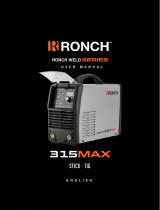
-- 9 --
bi19d2ea
In the 2 stroke control mode, pressing the TIG torch trigger switch (1) starts gas
pre--flow (if used) and strikes the arc. The current rises to the set value (as controlled
by the slope up function, if in operation). Releasing the trigger switch (2) reduces the
current (or starts slope down if in operation) and extinguishes the arc. Gas post--flow
follows if it is in operation.
4--stroke
With 4 stroke, the gas pre--flow starts when the welding gun trigger switch is pressed
in and the arc is struck when it is released. Th e welding process continues until the
switch is pressed in again, the arc is extinguished when the switch is released the
gas post flow starts (if selected).
Gas pre--flow Slope
up
Slope down Gas post--
flow
Functions when using 4 stroke control of the welding torch.
In the 4 stroke control mode, pressing the trigger switch (1) starts gas pre--flow ( if
used). At the end of the gas pre--flow time, the current rises to the pilot current (a few
ampere), and the arc is struck. Releasing the trigger switch (2) increases the current
to the set value (with slope up, if in use). When the trigger switch is pressed in (3)
the current returns to the set pilot current (with ”slope down” if in use). When the
trigger switch is released again (4) the arc is extinguished and any gas post flow
occurs.
Material thickness
The current is set automatically due to material thickness (mm/inch).
To increase or decrease the current, push on
until the symbols for material
thickness, slope down and gas post flow no longer are active and set the current.
Gas post--flow
This controls the time during which shielding gas flows after the arc is extinguished.
Active panel
Settings are made from the control panel.
Changing trigger data
This function permits changing between different welding data memories by a double
press on the trigger of the welding gun. Only applies for T IG welding.
GB

















